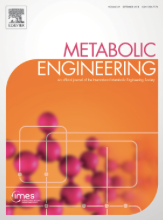| Title | Generation of an atlas for commodity chemical production in Escherichia coli and a novel pathway prediction algorithm, GEM-Path. |
| Year of Publication | 2014 |
| Authors | M.A. Campodonico; B.A. Andrews; J.A. Asenjo; B.O. Palsson; A.M. Feist |
| Journal | PLoS Comput Biol |
| Abstract | The production of 75% of the current drug molecules and 35% of all chemicals could be achieved through bioprocessing (Arundel and Sawaya, 2009). To accelerate the transition from a petroleum-based chemical industry to a sustainable bio-based industry, systems metabolic engineering has emerged to computationally design metabolic pathways for chemical production. Although algorithms able to provide specific metabolic interventions and heterologous production pathways are available, a systematic analysis for all possible production routes to commodity chemicals in Escherichia coli is lacking. Furthermore, a pathway prediction algorithm that combines direct integration of genome-scale models at each step of the search to reduce the search space does not exist. Previous work (Feist et al., 2010) performed a model-driven evaluation of the growth-coupled production potential for E. coli to produce multiple native compounds from different feedstocks. In this study, we extended this analysis for non-native compounds by using an integrated approach through heterologous pathway integration and growth-coupled metabolite production design. In addition to integration with genome-scale model integration, the GEM-Path algorithm developed in this work also contains a novel approach to address reaction promiscuity. In total, 245 unique synthetic pathways for 20 large volume compounds were predicted. Host metabolism with these synthetic pathways was then analyzed for feasible growth-coupled production and designs could be identified for 1271 of the 6615 conditions evaluated. This study characterizes the potential for E. coli to produce commodity chemicals, and outlines a generic strain design workflow to design production strains. |
| URL | http://www.ncbi.nlm.nih.gov/pubmed/25080239?dopt=Abstract |
| PubMed ID | 25080239 |
